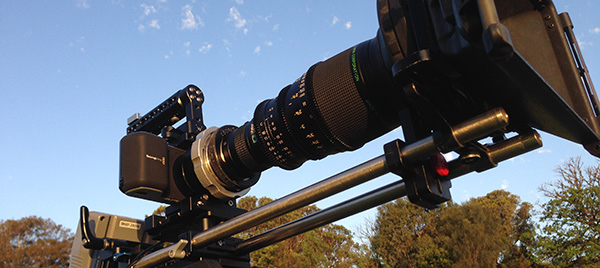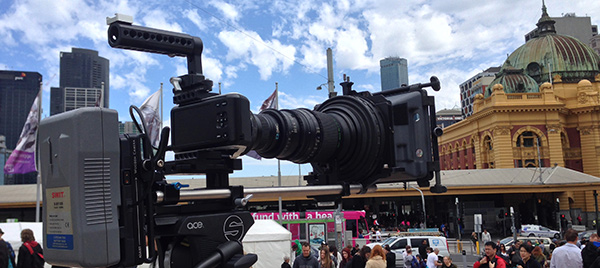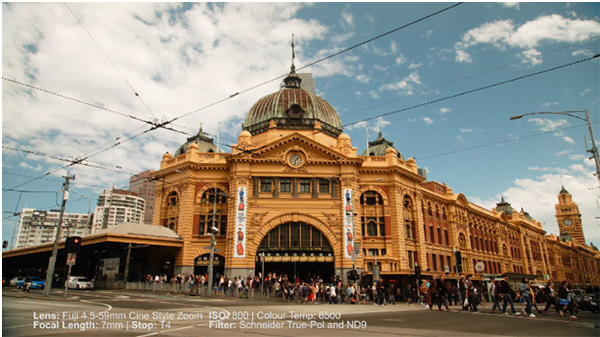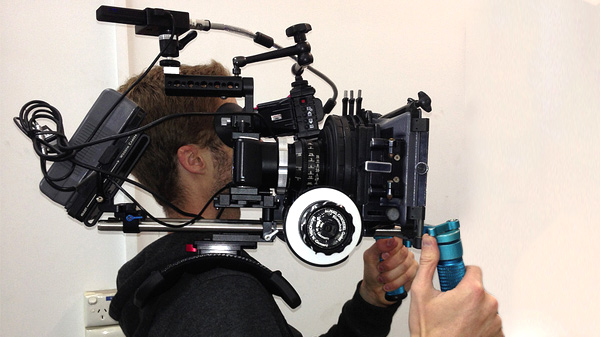Report by Lemac staff member Brett Williams:
Here at Lemac we have a long history of supporting Super-16 film production, which is now possible in the digital realm thanks to the arrival of the Blackmagic Pocket Cinema Camera.*
The Pocket Cinema camera is the size of a point-and-shoot stills camera, with a sensor that is just slightly smaller than a Super-16 film frame and is currently capable of recording 10-bit 4:2:2 Apple ProRes HQ to SD cards, with RAW support on the way. In addition to this, the camera can shoot in a ‘film’ gamma, giving you a flat gamma curve for maximum latitude in colour correction.
Natively, the camera has an active Micro Four Thirds lens mount, making it compatible with a wide range of MFT lenses from the likes of Panasonic, Olympus and Voigtlander, and easily adapted to other lens mounts thanks to it’s shallow flange depth.
From this small package, numerous creative possibilities emerge. The combination of a near Super-16 sensor size and the ability to adapt mounts have suddenly opened the doors to a huge range of lenses designed for Super-16 film and 2/3” HD cameras.

The purpose of this test, besides the chance to use the camera in the field and see how it performed, was to see what kind of results I could get using a Cine Style 2/3” HD Zoom Lens – in this case a Fujinon 4.5-59mm. I would occasionally compare it against similar shots recorded with a Panasonic Micro 4/3 lens, the 12-35mm Lumix lens, and use filters interchangeably.
Prior to shooting this test, I also tested the camera with various Super-16 film lenses including Zeiss primes and Canon zooms. Click here for a full list of Super-16 lenses available.
In order to use these different lenses, however, I also needed a rig. Wooden Camera have come up with some fantastic solutions for the Blackmagic Pocket Cinema Camera, and for this I used their Quick Kit, which includes a cage and top handle, and their PL Mount.
In order to mount the HD lens, I used an Optex B4 to PL adaptor from our Rental inventory. While this does create some magnification, the wide angle of the Fuji 4.5mm was more than enough! Also, because video lenses are able to be backfocussed on the lens itself, I was able to set this before shooting so that the lens would hold focus throughout the range.
The entire test was shot in film gamma and recording to ProRes HQ. Raw recording had not been enabled at the time of shooting.
Concluding Thoughts, Benefits and Issues
To shoot this test I used two cameras – one in the Wooden Camera rig with the 4.5-59mm Fuji, the other stripped down to bare bones and with the Panasonic Lumix 12-35mm. Out of the box, you do have the ability to shoot very high quality video with the appropriate lens, but you would benefit greatly from having a tripod. Also, in this configuration there is limited ability to attach accessories.
The accessory that I most wished for while shooting was a Zacuto Z-Finder EVF. Earlier in the week, I had tested the camera with the Zacuto EVF and found features such as Magnify (pixel-to-pixel) and focus peaking invaluable. The focus peaking on the BMPC, unfortunately, leaves a little to be desired: only one colour option, and difficult to gauge for small details in shot. As a result, I did lose focus on one or two wide shots in low light. At the time, as we had no stock of the mounts, I held off on taking an EVF with me- but would certainly not make that error again.

All of the shots in this video are from a tripod, and that is because stability is not an easy thing to come by with this camera. Our initial tests with the unit, unsurprisingly, took us back to the days of shooting DSLRs all over again! We have come up with some great solutions for handheld using the Zacuto QR Shoulder Pad and Kessler Kwik Release Plate (when the camera is rigged up in ‘production mode’ so to speak); otherwise, ultralight options such as the Zacuto Marauder have also been employed successfully.
Another issue with the camera is knowing how much media is left. Currently, the camera gives no indication until your card is full – something that needs to be resolved as soon as possible.
A primary reason for this test was also on the use of filters. Not entirely unexpectedly, infra-red is a potential issue. While shooting with an ND9 and Polariser at 800 ISO in film gamma, IR pollution was very noticeable. In order to get around this, IRND filters will be necessary. We ran a test using both the Schneider Platinum and the Tiffen T1 IR ND filters, and both brands worked well to correct this issue. To learn more about IR and Far Red issues, read Stuart Pointon’s excellent article on the subject.
While some of these issues may be cause for concern, they’re nothing new to professional cinematographers and camera operators, and the solutions are all there to be found. So what about the existing benefits? One thing that is evident with the Blackmagic Cinema Cameras is that they’re designed for the colourist in mind.
We have released this test video with a grade applied by Tim Schumann here at Lemac, but we’d also love to see what you can make of it. We’ve exported a ProRes HQ ungraded version that is available for download. If you are interested in downloading this, please contact me on brettw@lemac.com.au and I’ll send you the details.
Tim had this to say about the grade:
"Working with the Blackmagic Pocket in Resolve is really quite a pleasure. Log-like images recorded straight to a decent codec in 10-bit is a big step forward from 8-bit 4:2:0 images that we are used to seeing from DSLRs and other point-and-shoot sized cameras. Sure you won't find as much room to grade as an F65 or Alexa but for the price of the BMPC the images are pretty incredible. There's a ton of indie camera guys out there who are going to be thrilled with what they can pull off with this little Super-16 camera."

Still image taken from the test video above.
This camera produces a very filmic look that is more akin to actual 16mm than any other digital camera I’ve seen. It is not squeaky clean or ultra sharp. The pictures have grain and a texture to them. If anything, it produces a picture that is arguably a Super-16 equivalent of Alexa – flat, organic and with smooth roll offs into shadows and highlights. In the right hands in production and post, the two could intercut seamlessly.
It is also very low on power consumption. A single V-lock battery on this rig runs the camera all day without fail, and will also provide D-tap output for other accessories.
The option to go ultra-low profile is a huge plus. Also, viewers will see from this test that the ‘black hole’ issue seen in earlier models of this camera (a dark spot appearing in the middle of blown out highlights) is no longer an issue since the camera was calibrated by Blackmagic.
The creative options for different lenses is one of the most exciting things about this camera. Lemac Rentals stocks a huge range of excellent quality glass in both Super-16 and HD which will work with this camera.
So – for anyone interested in shooting ‘Digital Super-16’, we have begun building up a kit for Rentals that would work with your camera – for more details check out this gallery on our Facebook page and stay tuned for when we have it ready to go. Suffice it to say, the early version is highly promising and feels like the proverbial cat on the shoulder!

The author with the prototype digital super-16 rig.
This camera and configuration could be used for virtually anything from commercials, short films and independent work endeavouring to get that 16mm ‘look.’ You tell us – we’re excited to see what you can come up with!
*Note: previous Super-16 digital solutions through Lemac have included the Silicon Imaging 2K cameras and RED cameras with the sensor cropped, but we feel the Pocket Cinema Camera has most fluidly integrated into the Super-16 ‘system’ so far.